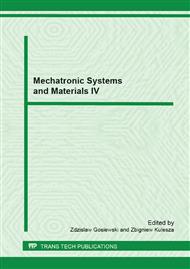p.378
p.382
p.388
p.394
p.400
p.406
p.412
p.421
p.427
Second-Order Model of the Radial Passive Magnetic Bearing with Halbach's Array
Abstract:
In the paper is presented model of the passive magnetic bearing. The response of bearing is approximate by second order model. There are presented the damping and stiffness coefficient of suspension. The coefficients derived from Biot-Savards law, Ohms law and Lorenzs force. There is presented loop with molecular current as a model of magnet, final formula of damping and stiffness coefficients and static characteristic of passive magnetic bearing.
Info:
Periodical:
Pages:
400-405
Citation:
Online since:
March 2013
Authors:
Keywords:
Price:
Сopyright:
© 2013 Trans Tech Publications Ltd. All Rights Reserved
Share:
Citation:


